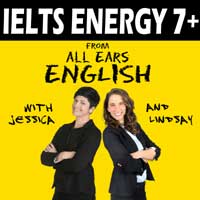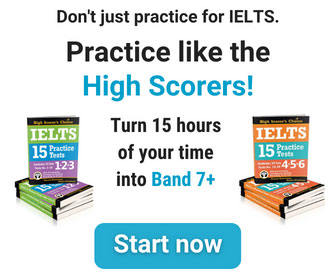3 Sentence Structures for a Band 7+ on Writing Task 1 Comparing Numbers
The following article was written by Jessica Beck, from All Ears English. Jessica has been working in the IELTS field for more than 10 years, and today she shares some great tips for writing a Band 7+ Writing Task 1.

This is one of students’ biggest worries when it comes to IELTS.
I’ve seen students go through grammar books from front to back, doing all the exercises, spending hours of their lives, trying to memorize every English grammar rule in the universe.
However, this doesn’t help them to write or speak any better. So, good news students! You really don’t need to do that.
What are you graded on?
Let me tell you why. You are actually graded on four things in writing: Task Achievement/Task Response, Coherence/Cohesion, Grammar and Vocabulary.
All four categories are equal. Plus, and here’s the most comforting thing, you DO NOT need perfect grammar to get a high score in this category.
Even at band score 9, the description says that there can still be minor errors, such as ‘slips’ that a native speaker would make.
The band score 7 description likewise notes that there will still be some errors present in the writing.
What do examiners care about?
So, what do the examiners care about most, since they don’t expect you to have perfect grammar? Sentence structure.
A variety of sentence structures is the most important factor in order to get a 6 or higher for your grammar score.
You can see more about what the examiner looks for here.
As you probably know, in Writing Task 1, you will most likely be given a graph, table or chart to write about.
Basically, you need to be able to choose the most important numbers you see and compare them in your response.
There are actually two types of “number questions” – Change Over Time (usually a line graph, showing how numbers change over time, such as The Number of Factories from 2000-2015), or Static (often a table or bar chart, showing numbers for one point in time, such as People with Full-time Work in One European City, 2014).
Sentence structures you should use:
Below are three high level sentence structures, and examples, for both of these question types.
Change Over Time example: While the number of factories in Taiwan increased dramatically to 100,000 in 2006, the quantity in Japan plummeted to 1,000 at the same time.
Static example: As the number of females in full-time work stood at 300 in 2014, the amount of working males stood at 500.
COT example: In comparison to the number of factories in Taiwan, which saw an increase to 100,000 in 2006, the quantity in Japan plummeted to 1,000 at this time.
Static example: In comparison to the number of females in full-time work, which stood at 300 in 2014, the amount of working males stood at 500.
COT example: The number of factories in Taiwan saw an increase to 100,000 in 2006, exceeding the quantity in Japan, which had only 1,000.
Static example: The number of males in full-time work reached 500 in 2014, exhibiting a higher number than all the other categories provided.
As you can see, the sentences above all contain numbers, which you must have in order to get a 6 or higher in Task Achievement.
Plus, they all use high-level vocabulary, most assuredly earning an 8 or 9 in that category.
What should you do next?
The next step for you, students, is to practice these structures.
Find some IELTS example test questions, and practice using these sentence structures to describe the important numbers you see on the graphs and charts.
Also, read the business or finance section in the newspaper for more high-level sentence structures and vocabulary to describe numbers.
Finally, if you’d like more tips, strategies, and IELTS information, please visit All Ears English IELTS online and sign up for our emails and cheat sheets!
Good luck, and keep working hard!
IELTS is definitely a tough test, but it’s not unbeatable!
About Jessica:
Jessica Beck has worked in the IELTS field for more than ten years. She is the co-host of IELTS Energy and is the IELTS expert at All Ears English.
At All Ears English we use smart systems and strategies that show you how to focus on the right things to get a 7 or higher on the IELTS.

